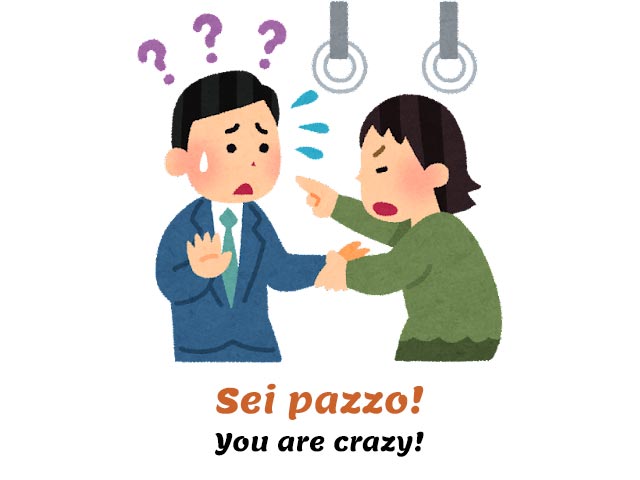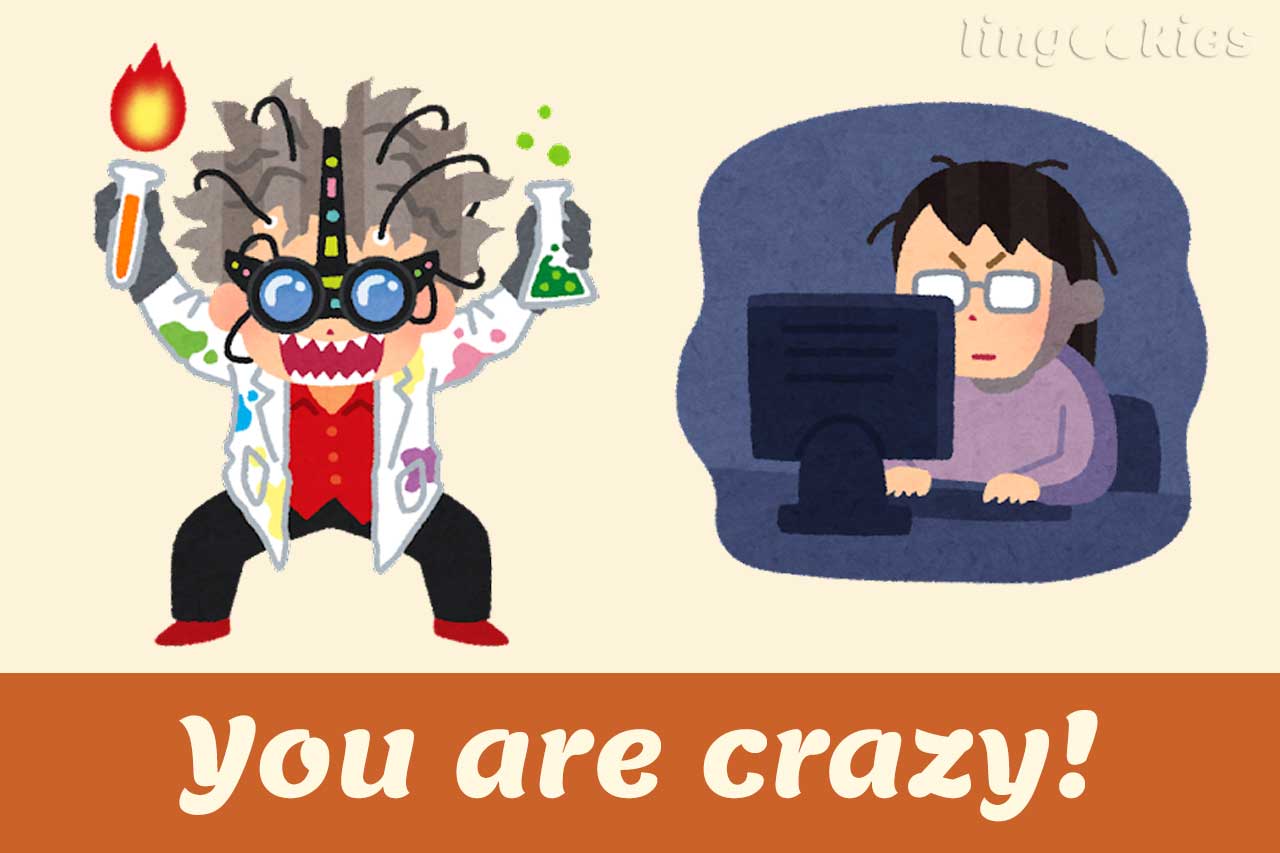How exactly do you say you are crazy in Italian?
In this lesson, we will take a look at the different ways you can translate this sentence into Italian. Read on to learn them all!
Let’s get started! Iniziamo!
How do you say you are crazy in Italian?
Singular: Sei pazzo! Sei pazza!
Sei pazzo and sei pazza are the most common translations for you are crazy in Italian when you are addressing only one person.
Sei pazzo!
You are crazy!
(singular, informal, masculine)
Sei pazza!
You are crazy!
(singular, informal, feminine)

The reason why there are two forms of the adjective “crazy” is that, unlike English, Italian has two genders: masculine and feminine.
Every noun and adjective must match that gender. So if you’re talking to a man, you’ll use pazzo because that’s the masculine adjective. If you’re talking to a woman, you’ll use pazza, because that’s the feminine form of the adjective.
That said, this common sentence in Italian is made up of two elements.
Sei
You are, singular
Pazzo/a
Crazy
Sei pazzo, Lorenzo, se credi di poter scalare quel monte!
You are crazy, Lorenzo, if you think you can climb that mountain!
Alice, non mettere i fogli di alluminio nel microonde! Sei pazza!
Alice, don’t put aluminum foil in the microwave! You are crazy!

If you want to emphasize your point, you can make the subject pronoun explicit by using tu, which means “you” in the singular.
Tu sei pazzo!
You are crazy! (m)
Tu sei pazza!
You are crazy! (f)
Sei is the second person singular present tense conjugation of essere, to be, in the present tense.
Present tense conjugation for essere
| io | sono |
| tu | sei |
| lui, lei | è |
| noi | siamo |
| voi | siete |
| loro | sono |
For example, you could say…
Sara, dove sono i tuoi genitori?
Sara, where are your parents?
Il salone è spazioso e molto luminoso.
The living room is spacious and very bright.

Now, what do you have to say to tell a group of people you are crazy in Italian? You will need to conjugate the verb essere in the second person plural. Let’s see what this form is in the next paragraph.
Plural: Siete pazzi! Siete pazze!
Siete pazzi and siete pazze are the translations for you are crazy in Italian when you are addressing more than one person.
Siete pazzi!
You are crazy!
(plural, masculine)
Siete pazze!
You are crazy!
(plural, feminine)
In Italian, unlike English, there are two kinds of “you”. There is a singular “you” and then there is a plural “you”. If you’re speaking to a group, you’ll need to conjugate any verb or pronoun accordingly, and don’t forget the gender!
Look again at the conjugation table. The subject pronoun for the second person plural is voi, and its essere verb conjugation is siete.
As we said, we’ll also have to change the gender of the adjective itself in its plural forms:
- pazzi, masculine plural
- pazze, feminine plural

There’s another caveat here.
You will use the masculine form of the adjective if there’s at least one male in the group you are talking to.
If there are only women or girls in the group, then use the feminine form of the adjective.
Nuotate in mare in pieno inverno? Siete pazzi!
You’re swimmin in the sea in the middle of winter? You are crazy!
Ragazze, voi siete pazze. Non penserete davvero di dormire nel bosco, vero?
Girls, you are crazy. You are not really thinking of sleeping in the woods, are you?
Of course, if you want to emphasize your statement, you can add the subject pronoun to the sentence.
Voi siete pazzi!
You are crazy! (m)
Voi siete pazze!
You are crazy! (f)
Now, how do you say you are crazy in Italian when you have to be polite? Read on to find out!
Formal: Lei è pazzo! Lei è pazza!
If you are just visiting Italy and often meet new people, unless you both agree to use the informal pronoun tu, you will have to stick to the polite pronoun Lei when talking to other adults and people you do not know. With children, it’s customary to use tu regardless of familiarity.
This is the equivalent of she in English. Basically, when speaking formally, Italians address each other with the subject “she”, lei.
So how do you formally say you are crazy in Italian?
Lei è pazzo!
You are crazy!
(singular, polite, masculine)
Lei è pazza!
You are crazy!
(singular, polite, feminine)
You can also omit the subject pronoun, although this sounds less common to my native ear.
È pazzo!
You are crazy! (m)
È pazza!
You are crazy! (f)

However, I wouldn’t really use this polite form with anyone.
Sei matto!
Sei matto/a, along with its plural and polite forms siete matti/e and è matto/a, is another way to translate you are crazy in Italian.
Matto is another translation for crazy in Italian, but it’s less common. However, it behaves just like pazzo because it must match the gender and number of the person(s) you are referring to.
Of course, forms that include the subject pronouns are also possible and common, like tu sei matto and voi siete matti.
Sei matto
You are crazy (singular, informal)
Siete matti
You are crazy (plural)
È matto
You are crazy (polite)
And that’s the end of our lesson on how to say you are crazy in Italian in all its forms!
What next?
➡️ Learn other common Italian questions!
Now that you’ve seen how to say you are crazy in Italian, you might want to keep learning Italian online with these free Italian resources:
❤️ If you liked this lesson on how to say you are crazy in Italian, consider sharing it with your social media friends who are also studying Italian.



